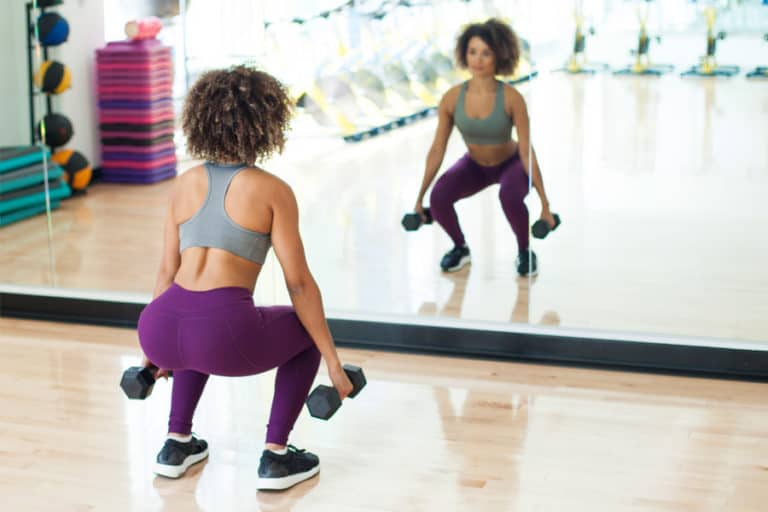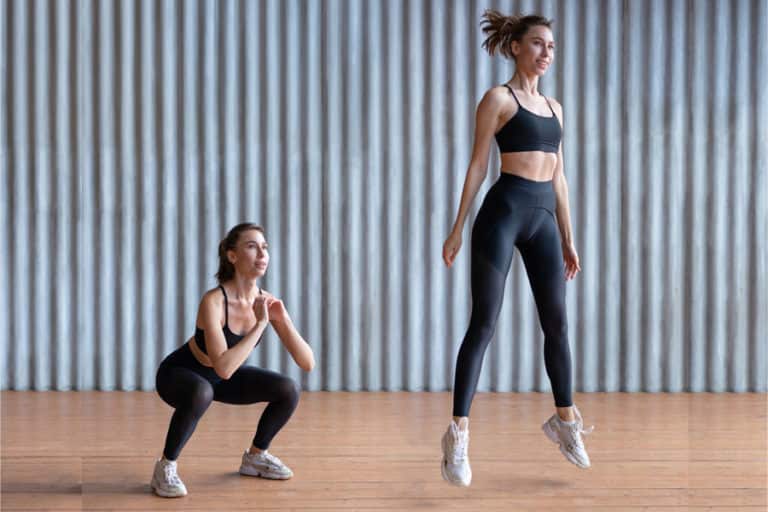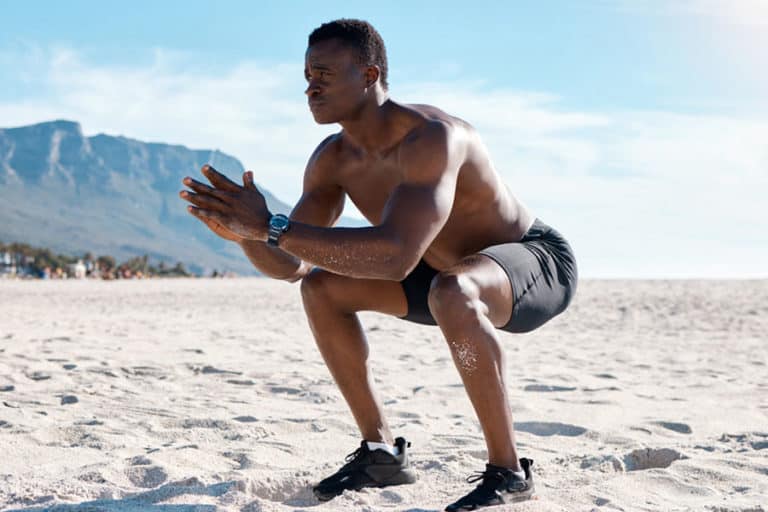Mastering Seated Calf Raise: Tips, Benefits, And Variations

How to do | Muscles Worked | Tips | Benefits | Variations | Alternatives | Add to routine
The calves play a crucial role in movement and balance, making them essential for various exercises such as running, jumping, and biking.
However, they are often overlooked and neglected, possibly due to the belief that they are less important than other muscle groups.
The seated calf raise is a highly effective exercise that specifically targets and strengthens the calves, making it a valuable addition to any workout routine.
How to do a seated calf raise?
Seated calf raises can be done using a seated calf raise machine or with a bench and free dumbbells. However, machine seated calf raise is the most effective and safe way to do this exercise.
So, here is how to do a seated calf raise using the machine:
- Sit on the seated calf raise machine and place the balls of your feet on the platform, keeping your toes pointed forward. Your heels should naturally hang off the edge.
- Place the base of your quadriceps under the knee pad and rest your hands on top.
- Release the safety bar and extend your ankles, lifting your heels as high as possible to fully stretch your calves.
- Slowly flex your ankles and return your heels to the starting position.
- Repeat the entire movement for a desired number of repetitions.
Seated calf raise: muscles worked
The calf muscles comprise the gastrocnemius and soleus muscles. Although seated calf raises effectively work the entire calf, they primarily target the soleus muscle rather than the gastrocnemius muscle.
Gastrocnemius muscle
The gastrocnemius muscle is the larger of the two calf muscles, originating from the back of the thigh and knee and providing bulk size to the calf.
It is crucial for leg movement and propelling force, earning it the nickname “runner’s muscle,” and is primarily activated during standing calf raises.
Soleus muscle
The soleus muscle is flat and lies under the gastrocnemius muscle, originating from the lower leg bones and attaching to the heel via the Achilles tendon.
It plays a vital role in basic activities like walking and contributes to stability, making it an important muscle despite being less visible than the gastrocnemius.
Tips for doing seated calf raises
Here are the tips for you to do a seated calf raise exercise with proper form:
1. Start with lightweights
To prevent muscle soreness or strain in your calves, it’s best to avoid using heavy weights right from the start.
Instead, begin with lighter dumbbells to ensure proper execution of the calf raise exercise. This will minimize the chances of injuring muscles that may not be accustomed to heavy loads.
2. Don’t slouch
Sit at the edge of your chair with an erect back and shoulder blades pinched together throughout the exercise to prevent pressure on your lower back.
You can also use the chair’s back support to make it easier and ensure your mid-back stays in touch with support.
3. Squeeze your calves
For maximum contraction, squeeze your calves for one to two seconds at the peak of the movement.
This adds intensity and increases muscle response, which is necessary for strengthening, building, and toning your calves.
4. Keep your movements slow
Perform slow and controlled repetitions to avoid using momentum to propel the movement. Using momentum reduces intensity and contractions in your calves. Take it slow and squeeze your calves at the top of your movement.
5. Don’t use your toes
Avoid pushing through the base of your toes and instead lift with the ball or mid-part of your feet. This serves the purpose of the seated calf raising better.
6. Use a full range of motion
To get the best results from your calf raise, perform it with a full range of motion by dropping your heels and raising them as far as they will go.
7. Listen to your body
If you sense a pinching sensation in your calf or foot while doing calf raises, slow down and move cautiously to prevent straining your calf muscle. Doing the full range of motion is recommended, but take it easy to avoid any injury.
Benefits of the seated calf raise
Here are some of the benefits of this exercise:
1. Builds strong calves
One way to increase the size of your calf muscles is to target them from all angles using proper biomechanics. While most people tend to perform calf raises only from a standing position, this neglects the soleus muscle.
Hence, building the soleus muscle is crucial to increasing overall calf size. An effective exercise for building strength in both the gastrocnemius and soleus muscles is the seated calf raise.
2. Improves balance
Strong calves play a crucial role in stabilizing the foot and ankle joints and help balance the upper body during intense movements such as walking, running, and plyometric exercises.
Additionally, a study [1]National Library of Medicine: Effect of calf-raise training on rapid force production and balance ability in elderly men on the effect of calf-raise training found that calf-raise exercises significantly contribute to balance improvement.
3. Reduces risk of injury
A study [2]PubMed: Calf muscle strain injuries in sport: a systematic review of risk factors for injury suggests that calf muscle injuries are becoming more common in athletes, possibly due to neglecting this muscle group in favor of more visible muscles.
The seated calf raise exercise effectively activates, engages, and strengthens calf muscles, reducing the risk of injury during functional and sports activities, despite its lower intensity than the standing variation.
4. Improves performance
Strong calf muscles are essential for many activities, including running, jumping, and sprinting. By strengthening your calves with seated calf raises you can improve your athletic performance in these areas.
5. Fixes leg muscle imbalances
Overusing legs often leads to muscle imbalances. Doing seated calf raises helps to build strength in your soleus muscles, which can help fix muscle imbalances in your legs.
Seated calf raise variations
There are various variations of the seated calf raise exercise that you can incorporate into your workout routine to strengthen and tone your calf muscles:
1. Seated dumbbell calf raise
If you don’t have access to a calf raise machine, the seated dumbbell calf raise is an excellent variation that requires only a weight bench and dumbbells. It is a highly effective exercise for building strength and size in your calf muscles with minimal equipment.
The use of dumbbells as resistance adds an additional challenge to the exercise, which enables progressive overload to further stimulate muscle growth.
2. Barbell seated calf raise
While some people may prefer the convenience of using dumbbells, others may find it easier to control barbells. For those who prefer barbells, the barbell seated calf raise is an excellent exercise for building calf strength and size.
3. Smith machine seated calf raise
The Smith machine seated calf raise is similar to the barbell variation, but provides assistance like a spotter. It allows you to focus on perfecting your form, while still providing the necessary resistance for muscle growth.
Alternatives
There are various effective alternatives to the seated calf raise that you can incorporate into your workout routine for building strong and healthy calves.
1. Standing calf raise
Seated calf raises target the soleus muscle, while standing calf raises are more suitable for targeting the gastrocnemius muscles.
Though they recruit less of the soleus muscle, standing calf raises allow for better development of mass and definition in the calves, making it the superior calf exercise for those who aims for good looking calves.
2. Leg press calf raise
To add some variety to calf training routine, you can try the leg press calf raise instead of the seated calf raise for a more machine-based training approach.
While both exercises have similar range of motion and muscular recruitment, the leg press calf raise is more effective for building mass in the gastrocnemius.
Additionally, the exercise provides a lengthier time under tension and reduces the risk of injury due to the features of the leg press machine.
3. Donkey calf raise
The donkey calf raise is another effective alternative to the seated calf raise. It challenges your calves differently compared to seated calf raises, and targets the calves and hamstrings effectively.
This exercise can be done either with a partner or with a machine, making it a great choice for those looking to add variety to their calf training.
Adding it to routine
Here is a basic lower body workout plan that features the seated calf raise exercise to help you strengthen your calves.
The routine also includes compound movements like squats and lunges that can effectively engage all the lower body muscles and some upper body muscles for a complete workout.
| Exercise | Sets x Reps |
| Glute bridge | 2 sets x 10 reps |
| Walking Lunges | 2 sets x 12 reps |
| Air squats | 2 sets x 7 reps |
| Dumbbell squats | 2 sets x 8 reps |
| Seated machine calf raises | 3 sets x 10 reps |
| Standing machine calf raises | 3 sets x 10 reps |
Conclusion
Incorporating seated calf raises into your workout routine can help improve your balance, stability, and athletic performance while reducing the risk of injury. It targets gastrocnemius and soleus muscles.
Seated calf raise can be performed at a gym or at home with the help of a calf-raise machine. Alternatively, it can also be done with a bench/chair and a pair of dumbbells.
By following the tips given above, you can perform the exercise safely and effectively for excellent strength and muscle build in the calf region.
References
| ↑1 | National Library of Medicine: Effect of calf-raise training on rapid force production and balance ability in elderly men |
|---|---|
| ↑2 | PubMed: Calf muscle strain injuries in sport: a systematic review of risk factors for injury |







